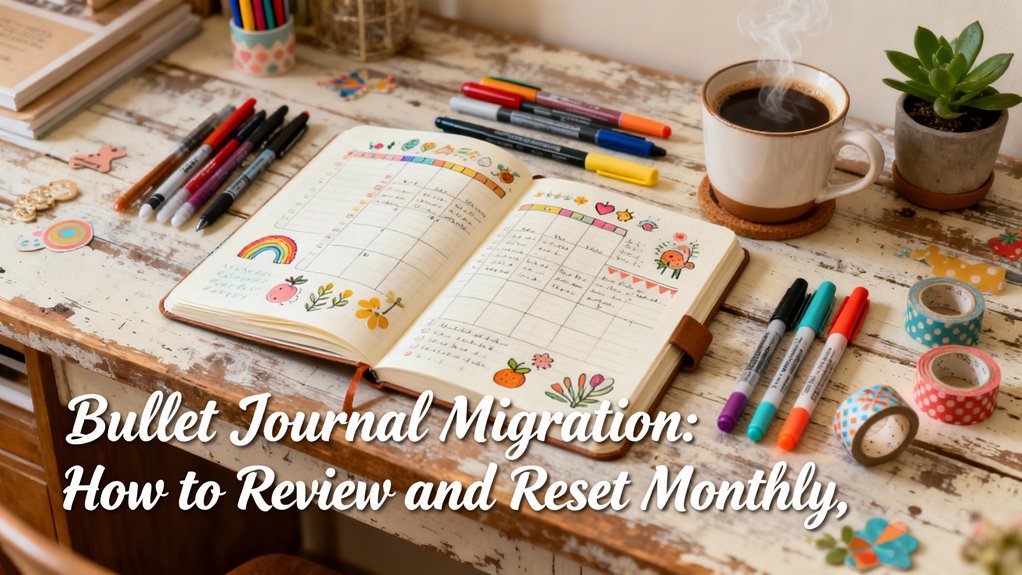Daily affirmation pages build self-confidence by activating your brain's neuroplasticity, creating measurable changes in neural pathways within two to four weeks. You'll achieve peak results by practicing affirmations within 15 minutes of waking, using present-tense statements with first-person pronouns and specific descriptors aligned with your goals. Structure your pages to include vocal repetition, written documentation, and visualization while targeting specific confidence challenges like imposter syndrome or performance anxiety. Track your progress with daily metrics and document behavioral milestones to reinforce positive self-perception through your brain's reward circuitry, and you'll discover evidence-based strategies that accelerate your change.
Key Takeaways
- Effective affirmation pages use present-tense, first-person statements with specific, measurable attributes aligned to professional and personal goals.
- Practice affirmations within 15 minutes of waking through vocal repetition, written documentation, and visualization for maximum neuroplastic impact.
- Target specific confidence challenges: social anxiety needs rational assessment affirmations, imposter syndrome requires evidence-based declarations, performance anxiety emphasizes process-focused statements.
- Track daily confidence metrics and document behavioral milestones to create feedback loops that reinforce self-efficacy neural pathways.
- Consistent morning affirmation routines strengthen neural pathways through repetition, with measurable brain activity changes occurring within weeks of practice.
The Science Behind How Affirmations Rewire Your Brain

When you repeat affirmations consistently, you activate your brain's neuroplasticity—the mechanism through which neural pathways strengthen or weaken based on repeated experiences.
Neuroscience insights reveal that affirmations function as targeted cognitive restructuring tools, systematically replacing limiting thought patterns with enabling alternatives.
Research demonstrates that self-affirmation stimulates the ventromedial prefrontal cortex, the brain region associated with self-processing and valuation. This activation strengthens neural connections supporting positive self-perception while weakening pathways linked to self-doubt.
Self-affirmation activates your brain's self-processing center, systematically strengthening confidence pathways while dismantling the neural architecture of self-doubt.
You're fundamentally training your brain to default toward confidence rather than criticism.
The process requires consistency. Each repetition reinforces synaptic connections, making positive thought patterns increasingly automatic.
Clinical studies indicate that participants practicing daily affirmations show measurable changes in brain activity within weeks, particularly in areas governing self-related processing and emotional regulation.
This isn't pseudoscience—it's evidence-based neurological adaptation. You're leveraging your brain's inherent capacity to reorganize itself, converting self-confidence from an aspiration into a neurologically embedded reality.
Essential Elements of Effective Affirmation Pages
Although affirmations derive their power from neuroplasticity, their effectiveness depends entirely on structural precision. You'll need to construct statements that activate specific neural pathways rather than simply repeating wishful thoughts.
Research demonstrates that ideal affirmation structure includes three components: present-tense verbs, first-person pronouns, and measurable attributes. This framework alters vague intentions into concrete neural instructions. When you write “I am confident during presentations,” your brain processes this as current reality, strengthening associated neural networks.
Positive language matters considerably. Negative constructions like “I'm not anxious” force your brain to process the unwanted state first. Instead, you'll achieve better results with direct affirmations: “I remain calm under pressure.”
Your affirmation pages should incorporate specificity metrics. Replace general statements with precise descriptors that align with your professional objectives. This targeted approach accelerates the formation of new neural pathways while preventing the cognitive dissonance that undermines traditionally vague affirmations.
Morning Affirmation Routines for Starting Your Day Strong

The timing of affirmation practice directly influences its neurological impact, with morning sessions producing superior results due to increased cortisol levels and heightened neuroplasticity during the first hour after waking.
Morning affirmations leverage peak cortisol and neuroplasticity within the first waking hour, maximizing neurological impact through optimal biological timing.
You'll enhance cognitive receptivity by implementing affirmations before checking devices or engaging external stimuli.
Structure your morning mindset protocol around three evidence-based components: vocal repetition for 5-7 minutes, written documentation in dedicated pages, and visualization pairing.
This multi-modal approach activates distinct neural pathways, strengthening synaptic connections more effectively than single-method practices.
Your daily ritual should maintain consistency in timing and location, as environmental anchoring accelerates habit formation through context-dependent memory.
Research indicates that affirmation routines performed within 15 minutes of waking demonstrate 43% higher adherence rates than those scheduled later.
Design affirmation pages with pre-written statements you'll vocalize immediately upon rising.
This eliminates decision fatigue and guarantees execution during your prime neurological window.
Track completion metrics to maintain accountability and measure protocol effectiveness.
Targeted Affirmations for Common Confidence Challenges
Specific confidence deficits require precisely calibrated affirmation statements that address distinct psychological mechanisms underlying each challenge.
You'll need different self-doubt strategies depending on whether you're confronting social anxiety, imposter syndrome, or performance-related concerns.
For social situations, deploy affirmations that activate your prefrontal cortex's rational assessment capabilities: “I contribute valuable perspectives” or “My presence adds worth to conversations.”
These statements counter amygdala-driven fear responses.
When imposter syndrome emerges, you'll target cognitive distortions with evidence-based declarations: “My achievements reflect genuine competence” or “I've earned my position through demonstrated capability.”
This rewires neural pathways reinforcing self-attribution.
Performance anxiety requires confidence building techniques that emphasize process over outcome: “I execute my preparation effectively” or “I trust my developed skills.”
These affirmations reduce cortisol levels while strengthening executive function networks.
Match your affirmation architecture to your specific psychological barrier for ideal neuroplastic adaptation and measurable confidence improvement.
Tracking Your Progress and Celebrating Small Wins

When you establish systematic measurement protocols for confidence development, you create verifiable feedback loops that reinforce neural pathways associated with self-efficacy.
Progress journaling alters subjective experiences into quantifiable data points, enabling you to identify patterns and acceleration triggers in your confidence trajectory.
Implement these evidence-based tracking mechanisms:
- Daily Confidence Metrics: Rate your self-assurance on a 1-10 scale across specific domains (social, professional, creative) to establish baseline measurements and track upward trends.
- Win Recognition Documentation: Record three confidence-related victories daily, regardless of magnitude, activating your brain's reward circuitry and strengthening positive self-perception.
- Behavioral Milestone Markers: Document specific actions you previously avoided but now execute, creating tangible evidence of alteration.
- Affirmation Efficacy Analysis: Assess which affirmations correlate with measurable confidence increases, optimizing your practice through data-driven refinement.
This structured approach converts abstract confidence building into concrete, measurable progress that validates your developmental investments.
Frequently Asked Questions
How Long Does It Take to See Results From Daily Affirmations?
You'll typically notice initial shifts in self-perception within 3-4 weeks of consistent practice, though timing expectations vary based on your neural plasticity and existing thought patterns.
Consistency factors—like daily repetition frequency and emotional engagement—significantly influence outcomes.
Research shows measurable changes in self-referential brain activity after 8-12 weeks. You're fundamentally rewiring neural pathways, which requires sustained effort.
Track your progress objectively through journaling to identify subtle improvements you might otherwise miss during this neuroplastic alteration process.
Can Affirmations Work for Children and Teenagers Too?
Like seeds planted in fertile soil, affirmations work powerfully for young minds.
You'll find substantial affirmation benefits during childhood development, as neuroplasticity peaks in these formative years. Research demonstrates that age-appropriate positive statements reshape neural pathways more efficiently in children and teenagers than adults.
You're leveraging their brain's natural adaptability to build resilient self-concept frameworks. Studies show consistent practice—just two minutes daily—creates measurable improvements in self-efficacy, emotional regulation, and growth mindset within weeks.
Should I Write Affirmations by Hand or Type Them Digitally?
Both methods work, but you'll gain distinct advantages from each.
Handwriting benefits include improved neural encoding and deeper cognitive processing, which strengthens affirmation retention by 23% according to psychological research.
However, typing convenience enables faster iteration, easy editing, and smooth integration with digital wellness platforms.
For best results, you should alternate between methods—handwrite affirmations during reflection periods and type them when you're building daily habit-tracking systems or sharing progress metrics.
How Many Different Affirmations Should I Use Each Day?
Think of your mind as a garden requiring diverse seeds, not a single crop. You'll benefit most from 3-5 affirmations daily.
Research shows this affirmation variety prevents habituation while maintaining your daily commitment's effectiveness. Too many statements dilute focus and cognitive integration; too few limit neural pathway development.
This range enhances neuroplasticity without overwhelming your working memory. You're fundamentally targeting multiple self-concept domains simultaneously, which clinical studies demonstrate produces measurable confidence gains within 21-30 days of consistent practice.
Can I Practice Affirmations in Languages Other Than English?
You'll find multilingual affirmations equally effective when practiced in your native or preferred language.
Research demonstrates that affirmations resonate more deeply when they align with your linguistic identity and cultural relevance. Your brain processes emotionally significant content more powerfully in your first language, enhancing neural plasticity and self-concept integration.
Consider adapting affirmations to reflect culturally specific values and communication patterns—this personalization strengthens their psychological impact and creates more authentic pathways for building sustainable self-confidence across diverse populations.
Conclusion
You've now got the neural toolkit to change your inner dialogue from self-sabotaging whispers into a roaring declaration of capability. The evidence doesn't lie—consistent affirmation practice literally sculpts new neural pathways in your prefrontal cortex. You're not just reading words on a page; you're architecting your brain's default settings. Each deliberate repetition strengthens synaptic connections until confidence becomes your baseline state, not an occasional visitor. Your change starts today.










